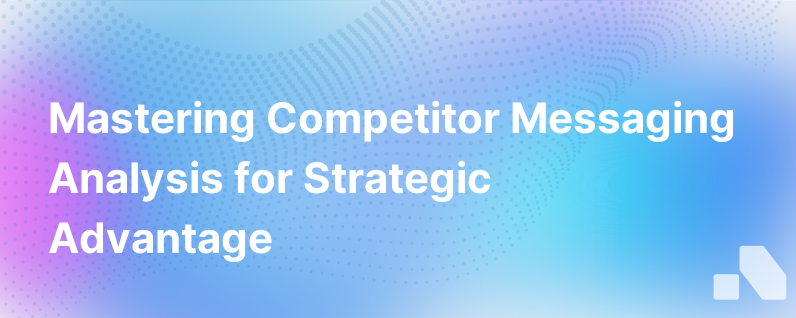How To Do A Competitor Messaging Analysis
Published on November 10, 2023 by Sawyer Middeleer
Great marketing begins with understanding your audience and their pain points. However, no marketing strategy is complete without a competitor messaging analysis. By analyzing the way your competitors communicate with their customers, you can uncover gaps in their messaging, capitalize on missed opportunities, and craft messages that truly differentiate your product in the market.
This guide will take you step-by-step through the process of conducting a robust competitor messaging analysis.
What is Competitor Messaging Analysis?
Competitor messaging analysis is a comprehensive process to evaluate and understand how your competitors communicate the value of their products to specific audiences. It involves scrutiny of various marketing channels like their website, emails, blog posts, social platforms, and customer testimonials.
Why You Should Conduct a Competitor Messaging Analysis
There are several reasons why a competitor messaging analysis is beneficial:
- Understand your competitors: Understanding your competitors' approach and value proposition can give you a clear perspective on what makes your product unique.
- Identify the gaps: Uncover opportunities in your competitors' marketing strategy and capitalize on them.
- Sharpen your marketing message: Improve your messaging by observing what works (or doesn't) for your competitors.
- Differentiate your brand: Develop a unique value proposition to stand out from the crowd.
How To Do a Competitor Messaging Analysis
-
Identify Your Competitors: Before you start, you need to identify your top competitors. Competitors can be divided into two categories, direct and indirect. Direct competitors offer a product similar to yours, targeting the same audience, while indirect competitors might offer a different product but still target your audience.
-
Gather Information: This step involves data collection. Dive into your competitors' websites, marketing materials, social media profiles, and any other platform they might be using to understand their messaging strategy. Take note of the key phrases they use, their language, the features and benefits they highlight, etc.
-
Analyze their Messaging: Once the necessary data is collected, try to understand the customer they’re addressing and the key aspects of their products they're emphasizing. Identify their unique selling proposition (USP) and the key values they express to their customers.
-
Assess Tone and Language: Marketing is not only about what you say, but also about how you say it. Pay attention to the tone and language your competitors use. Is it formal, casual, inspiring, or humorous? This insight reveals a lot about their target audience and their brand personality.
-
Review Content Strategy: Take a look at the content your competitors are creating. This will give you an idea of the topics they deem important, which can reflect their overall positioning in the market.
-
Analyze Customer Engagement: See how their customers are interacting with them. Are they engaged and excited about their product? Do they have any complaints or praises?
-
Identify Strengths and Weaknesses: Based on your analysis, list down your competitors’ strengths and weaknesses in their messaging strategy. This is vital to identify opportunities where your brand can shine.
Tools for Competitor Messaging Analysis
Several insightful tools to help you with this process are:
- SimilarWeb: Gives a high-level overview of competitors' web metrics.
- SEM Rush: Provides keyword search data for SEO optimization.
- Buzzsumo: Shows the most liked, shared, and talked-about content on social media.
- Ahrefs: Gives crucial insights into your competitors' backlink strategy.
- Google Alerts: Helps you monitor key Google search results for your competitors.
- Aomni: Utilized AI to automate your competitor messaging analysis by gathering and analyzing data in real-time.
Conclusion
A competitor messaging analysis is a key detail that should not be overlooked. It sheds light on the market landscape and helps you identify opportunities to make your brand unique. With the combined power of your team's knowledge and tools that leverage AI, like Aomni, you can efficiently perform this analysis and gain essential insights into your competitors' strategies. This will help you craft a strategic approach that sets your product apart from the crowd.